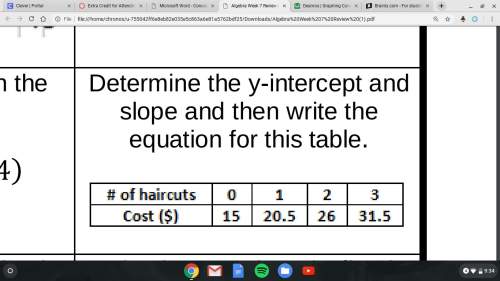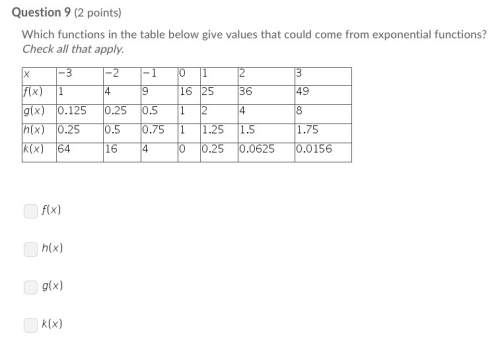
Mathematics, 01.09.2021 04:50 edwin3448
For the three part question that follows, provide your answer to each part in the given workspace. Identify each part with a response and label Part A, B and C.
The distance, d, an object travels from rest while accelerating in t seconds is given by the formula d = 1/2at², where a is the acceleration of the object.
Part A: Solve for the acceleration, a, to write the equation in terms of the distance, d, and time, t.
Part B: Solve instead for the time, t, and write the equation in terms of the acceleration, a, and distance, d.
Part C: Explain why it is useful to solve a formula for a specific variable.

Answers: 1
Another question on Mathematics

Mathematics, 21.06.2019 15:00
Which represents the inverse of the function f(x) = 4x? h(x) = x + 4 h(x) = x – 4 h(x) = x h(x) = x
Answers: 1

Mathematics, 21.06.2019 16:40
What is the average rate of change for this function for the interval from x=2 to x=4 ?
Answers: 2

Mathematics, 21.06.2019 17:00
In tossing one coin 10 times, what are your chances for tossing a head? a tail? 2. in tossing one coin 100 times, what are your chances for tossing a head? a tail? 3. in tossing one coin 200 times, what are your chances for tossing a head? a tail? deviation = ((absolute value of the difference between expected heads and observed heads) + (absolute value of the difference between expected tails and observed tails)) divided by total number of tosses. this value should always be positive. 4. what is the deviation for 10 tosses? 5. what is the deviation for the 100 tosses? 6. what is the deviation for 200 tosses? 7. how does increasing the total number of coin tosses from 10 to 100 affect the deviation? 8. how does increasing the total number of tosses from 100 to 200 affect the deviation? 9. what two important probability principles were established in this exercise? 10. the percent of occurrence is the obtained results divided by the total tosses and multiplied by 100%. toss the coins 100 times and record your results. calculate the percent occurrence for each combination. percent head-head occurrence: percent tail-tail occurrence: percent head-tail occurrence:
Answers: 3

Mathematics, 21.06.2019 17:30
Which of the following tables represents exponential functions?
Answers: 1
You know the right answer?
For the three part question that follows, provide your answer to each part in the given workspace. I...
Questions

Mathematics, 31.01.2020 20:44


Mathematics, 31.01.2020 20:45

History, 31.01.2020 20:45


Business, 31.01.2020 20:45



English, 31.01.2020 20:45




Mathematics, 31.01.2020 20:45


Mathematics, 31.01.2020 20:45

History, 31.01.2020 20:45

Mathematics, 31.01.2020 20:45


History, 31.01.2020 20:45

Mathematics, 31.01.2020 20:45





